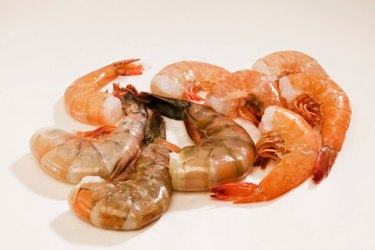Things You'll Need
Colander
Deveining tool
Freezer container
Container
Bowl
Ice
Cookie sheet
Freezer bags or containers

Many different varieties of shrimp are available, but they are all frozen using the same methods. Shrimp needs to be frozen differently when raw or cooked. Raw shrimp maintains the highest quality when the shell remains intact; the removal of the shell can cause a loss in the texture and flavor. Freezing the raw shrimp in water helps protect it from freezer burn. Frozen cooked shrimp does not retain flavor as well, but it freezes with ease. Once you properly freeze the shrimp, use it within the recommended storage time to prevent a loss in quality.
Raw Shrimp
Step 1
Rinse the raw shrimp under cool running water. Drain the shrimp in a colander.
Video of the Day
Step 2
Grab the head and pull on it to remove it from the body and discard.
Step 3
Hold the shrimp firmly. Pull the legs off the shrimp with your fingers.
Step 4
Insert a small deveining tool under the shell. Make a shallow cut along the back of the shrimp to expose the dark vein. Follow the curve of the knife and push it from the head to the tail. The vein will stick to the tool. Pull the vein off and discard.
Step 5
Place the desired amount of shrimp in a freezer container. Freeze the amount of shrimp that you plan to use for a meal. Fill the containers with cold water. Leave 1/2 inch of head space to allow for expansion.
Step 6
Place the shrimp in the freezer and store for up to six months for best results.
Cooked Shrimp
Step 1
Remove the vein from the shelled cooked shrimp if it still remains. Create a shallow cut along the back of the shrimp. Once you expose the vein, pull it out with your fingers or the sharp end of the knife.
Step 2
Chill the cooked shrimp quickly by placing it into a container. Place the container in a bowl filled with ice until it cools.
Step 3
Place the shrimp onto a cookie sheet. Freeze the shrimp in a single layer.
Step 4
Remove the shrimp. Store the shellfish packed into freezer bags or containers. Leave 1/4 inch of head space. Place the shrimp in the freezer. Use the shrimp within one to three months for best results.
Tip
Thaw frozen shrimp under cool running water or in the refrigerator.
Warning
Never thaw shrimp at room temperature or in hot water.
Never thaw shrimp and then refreeze it because it can spoil and it reduces the quality.
Avoid freezing shrimp that smells like ammonia because it has spoiled.
Video of the Day
- North Dakota State University; Food Freezing Basics; Julie Garden-Robinson; August 2005
- National Center for Home Food Preservation: Freezing Shrimp
- Clemson University; Freezing Meats and Seafood; P.H. Schmutz et al.; June 1999
- Fort Valley State University: Freezing Fish And Shellfish
- Recipe Tips: How to Prepare and Devein Shrimp